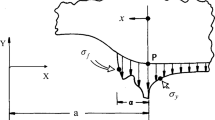Abstract
This article finds the energy of slightly kinked crack fronts in order to find the rate at which thermal fluctuations cause cracks to creep in three-dimensional settings.
Similar content being viewed by others
REFERENCES
D. Bensimon, L. P. Kadanoff, S. Liang, and B. I. Shraiman, Viscous flows in two dimensions, Rev. Mod. Phys. 58:977–99 (1986).
R. Thomson, C. Hsieh, and V. Rana, Lattice trapping of fracture cracks, J. Appl. Phys. 42(8):3154–3160 (1971).
R. Thomson, The physics of fracture, Solid State Physics 39:1–129 (1986).
J. J. Gilman and H. C. Tong, Quantum tunneling as an elementary fracture process, J. Appl. Phys. 42:3479–3486 (1971).
J. E. Sinclair, The influence of the interatomic force law and of kinks on the propagation of brittle cracks, Philosophical Magazine 31:647–71 (1975).
A. S. Krausz and J. Mshana, The steady state fracture kinetics of crack front spreading, Inter. J. Fract. 19:277–93 (1982).
I. H. Lin and J. P. Hirth, On brittle crack advance by double kink nucleation, J. Mater. Sci. 17:447–60 (1982).
Sharad Ramanathan and Daniel S. Fisher, Dynamics and instabilities of planar tensile cracks in heterogeneous media, Phys. Rev. Lett. 79:877–880 (1997).
C. Hsieh and R. Thomson, Lattice theory of fracture and crack creep, J. Appl. Phys. 44:2051–2063 (1973).
B. R. Lawn, An atomistic model of kinetic crack growth in brittle solids, J. Mater. Sci. 10:469–80 (1975).
A. J. Markworth and J. P. Hirth, An atomistic model of crack extension by kink propagation, J. Mater. Sci. 16:3405–17 (1981).
R. Thomson, V. K. Tewary, and K. Masuda-Jindo, Theory of chemically induced kink formation on cracks in silica. I. 3-d crack Green's functions, J. Mater. Res. 2:619–30 (1987).
D. Holland and M. Marder, Ideal brittle fracture of silicon studied with molecular dynamics, Phys. Rev. Lett. 80:746–749 (1998).
M. Marder and S. P. Gross, Origin of crack tip instabilities, J. Mech. Phys. Solids 43:1–48 (1995).
Michael Marder, Statistical mechanics of cracks, Phys. Rev. E 54:3442–3454 (1996).
E. N. Economou, Green's Functions in Quantum Physics (Springer-Verlag, Berlin, 1983).
Author information
Authors and Affiliations
Rights and permissions
About this article
Cite this article
Marder, M. Energies of a Kinked Crack Line. Journal of Statistical Physics 93, 511–525 (1998). https://doi.org/10.1023/B:JOSS.0000033239.22129.c1
Issue Date:
DOI: https://doi.org/10.1023/B:JOSS.0000033239.22129.c1




